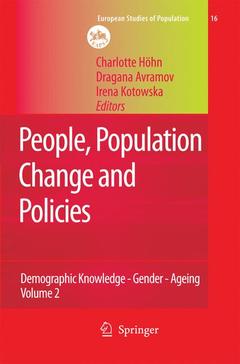People, Population Change and Policies, 2008 Lessons from the Population Policy Acceptance Study Vol. 2: Demographic Knowledge - Gender - Ageing European Studies of Population Series, Vol. 16/2
Langue : Anglais
Coordonnateurs : Höhn Charlotte, Avramov Dragana, Kotowska Irena E.

European countries, including the DIALOG countries, have faced a major de- graphic change and transition in the last thirty years. They are experiencing lo- term downward trends in fertility, leading to demographic ageing. Fertility rates are now below replacement level in nearly all countries. As a result, natural p- ulation growth rates are starting to decline, or population sizes are falling o- right. At the same time, the proportion of elderly dependants continues to grow while the working-age population declines in absolute and relative terms (see Kontula and Miettinen 2005). Moreover, net immigration, which potentially could offset declines in working-age population, remains generally low in most European countries (Grant et al. 2004). There are a great number of societal problems that arise from this demographic transition. The International Monetary Fund (2004) argues that the impact of - coming demographic changes on economical growth could be substantial. The h- toric association between demographicand macro-economicvariablessuggests that the projected increase in elderly dependency ratios and the projected decline in the share of the working-age population could result in slower per capita GDP growth, and lower saving and investment (IMF 2004, 147). For example, the estimates s- gest that demographic change could reduce annual real per capita GDP growth in 1 1 advanced countries by an average of / % point by 2050, i. e. , growth would be / % 2 2 point lower than if the demographic structure had remained the same as in 2000 (IMF 2004, 147).
Demographic Trends, Population Related Policies and General Attitudes.- Demographic Change and Family Policy Regimes.- Demographic Knowledge and Evaluation of Demographic Trends.- Who Should Take Care for Them?.- Changing Attitudes on Population Trends and Policies?.- Comparative Delphi-study.- 2030: Another Europe?.- Action Programs of Socio-political Actors.- Making Dialog Possible.- Gender Roles.- Family-related Gender Attitudes.- Gender and Fertility.- Intergenerational Solidarity and Elderly.- Attitudes Towards Population Ageing and Older People.- Activating Older Workers: Policies Versus Opinions and Expectations.- Only Fools Rush In?.- Policy Implications and Conclusions.- The Need to Adapt and Reform Social Policy: Setting the Stage for Effective Population-friendly Policies.- Conclusions.
International comparative analysis of surveys on demographic change based on about 34000 interviews in 14 European countries Lessons drawn on what future demographic trends will bring and what will be the consequences for the family, children, equal opportunities and the ageing of the population
Date de parution : 11-2014
Ouvrage de 346 p.
15.5x23.5 cm
Date de parution : 03-2008
Thème de People, Population Change and Policies :
© 2024 LAVOISIER S.A.S.



